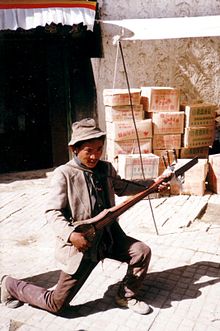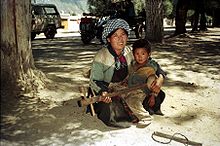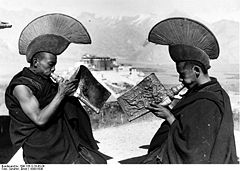- Music of Tibet
-
Part of a series on Tibetan Buddhism
History Timeline · Related-topics Schools Nyingma · Kagyu · Sakya · Gelug · Bön · Jonang Key concepts Three marks of existence · Skandha · Cosmology · Saṃsāra · Rebirth · Bodhisattva · Dharma · Dependent origination · Karma Major figures Gautama Buddha · Padmasambhava · Je Tsongkhapa · Dalai Lama · Panchen Lama · Lama · Karmapa Lama · Rinpoche · Geshe · Terton · Tulku Buddhahood · Avalokiteśvara · Four stages of enlightenment · Tantric yoga · Paramitas · Meditation · Laity Changzhug · Drepung · Dzogchen · Ganden · Jokhang · Kumbum · Labrang · Mindroling · Namgyal · Narthang · Nechung · Pabonka · Palcho · Ralung · Ramoche · Sakya · Sanga · Sera · Shalu · Tashilhunpo · Tsurphu · Yerpa Chotrul Duchen · Dajyur · Losar · Monlam · Sho Dun Texts Kangyur · Tengyur · Tibetan canon · Mahayana sutras · Nyingma Gyubum Sand mandala · Thangka · Ashtamangala · Tree of physiology Outline · Comparative studies · Culture · List of topics · Portal
The music of Tibet reflects the cultural heritage of the trans-Himalayan region, centered in Tibet but also known wherever ethnic Tibetan groups are found in India, Bhutan, Nepal and further abroad. First and foremost Tibetan music is religious music, reflecting the profound influence of Tibetan Buddhism on the culture.
Contents
History
The Lama Mani tradition - the telling of Buddhist parables through song — dates back to the 12th century. The songs were performed by wandering storytellers, who travelled from village to village, drawing on their own often humble origins to relate to people from all backgrounds. Vividly illustrated Buddhist thangka paintings depicted the narrative and helped the audience understand what was essentially a teaching.
Tibetan "street songs" were a traditional form of expression particularly popular as a means of political and other commentary in a country that was previously without newspapers or other means of mass communication. They provided political and social commentary and satire and are a good example of a bardic tradition, akin to that that in medieval Europe or, more recently, the role calypsos played in the West Indies. As song lyrics in Tibet usually contained stanzas of 4 lines of 6 syllables each, the lyrics could be easily adapted to almost any melody.[1]
Secular Tibetan music has been promoted by organizations like the Dalai Lama's Tibetan Institute of Performing Arts. This organization specialized in the lhamo, an operatic style, before branching out into other styles, including dance music like toeshey and nangma. Nangma is especially popular in the karaoke bars of the urban center of Tibet, Lhasa. Another form of popular music is the classical gar style, which is performed at rituals and ceremonies. Lu are a type of songs that feature glottal vibrations and high pitches. There are also epic bards who sing of Tibet's national hero Gesar.
Chanting
Tibetan music often involves chanting in Tibetan or Sanskrit, as an integral part of the religion. These chants are complex, often recitations of sacred texts or in celebration of various festivals. Yang chanting, performed without metrical timing, is accompanied by resonant drums and low, sustained syllables. Other styles include those unique to the various schools of Tibetan Buddhism, such as the classical music of the popular Gelugpa school, and the romantic music of the Nyingmapa, Sakyapa and Kagyupa schools.[2]
Popular and Modern
Tibetans have a very strong popular-music culture, and are also well-represented in Chinese popular culture. Tibetan singers are particularly known for their strong vocal abilities, which many attribute to the high altitudes of the Tibetan Plateau. Tseten Dolma (才旦卓玛) rose to fame in the 1960s for her music-and-dance suite "The Earth is Red". Kelsang Metok (格桑梅朵) is a popular singer who combines the vocal traditions of Tibet with elements of Chinese, Indian and Western pop. Purba Rgyal (Pubajia or 蒲巴甲) was the 2006 winner of Haonaner, the Chinese version of American Idol. In 2006, he starred in Sherwood Hu's Prince of the Himalayas, an adaptation of Shakespeare's Hamlet, set in ancient Tibet and featuring an all-Tibetan cast.
In the traditional region of Amdo (now the Chinese regions of Qinghai and Sichuan), there is a very strong local scene, mostly exposed through videos on local buses. Amdo stars are among others Sherten (short for Sherab Tendzin) [3] and Yadon, who both have reached outside the borders of China with their music.
Tibetan music has had a profound effect on some styles of Western music, especially New Age. Composers like Philip Glass and Henry Eichheim are most well known for their use of Tibetan elements in their music.[citation needed] The first such fusion was Tibetan Bells, a 1971 release by Nancy Hennings and Henry Wolff. The soundtrack to Kundun, by Philip Glass, has helped to popularize Tibetan music.
Foreign styles of popular music have also had a major impact within Tibet. Indian ghazal and filmi are very popular, as is rock and roll, an American style which has produced Tibetan performers like Rangzen Shonu. Since the relaxation of some laws in the 1980s, Tibetan pop, popularised by the likes of Yadong (Tibet), Dadon (now living in the US), Jampa Tsering (Tibet), 3-member group AJIA, 4-member group Gao Yuan Hong, 5-member group Gao Yuan Feng, are well known. Gaoyuan Hong in particular has introduced elements of Tibetan language rapping into their singles. Alan Dawa Dolma is the first and currently only Tibetan artist to break into the Japanese music industry.
See also
Footnotes
- ^ Goldstein, Melvyn C. (1982). "Lhasa Street Songs: Political and Social Satire in Traditional Tibet." The Tibet Journal. Vol. VII Nos. 1 & 2. Spring/Summer 1982, pp. 56-66.
- ^ Crossley-Holland, Peter. (1976). "The Ritual Music of Tibet." The Tibet Journal. Vol. 1, Nos. 3 & 4, Autumn 1976, pp. 47-53.
- ^ http://www.travelblog.org/Asia/China/Tibet/blog-148408.html
References
- Crossley-Holland, Peter. (1976). "The Ritual Music of Tibet." The Tibet Journal. Vol. 1, Nos. 3 & 4, Autumn 1976, pp. 45–54.
External links
- Bibliography on Tibetan music
- MusicTibet- popular Tibetan music
- http://www.youtube.com/user/greybuffalo A YouTube users with a lot of tibetan pop music
- Art of the States: Tibetan Tunes work by composer Chen Yi inspired by Tibetan folk songs
Music of Asia Central Afghanistan · Badakhshan · Buryatia · Gansu · Kazakhstan · Khakassia · Kyrgyzstan · Mongolia · Tajikistan · Turkmenistan · Tuva · UzbekistanEast South Southeast Southwest Transcontinental Armenia · Azerbaijan · Cyprus · Egypt · Georgia (Ossetia) · Russia (Altai Republic · Sakha Republic) · TurkeyCulture Society Others Categories:- Tibetan music
- Music of Chinese subdivisions
- Classical and art music traditions
- Tibetan Buddhist art and culture
Wikimedia Foundation. 2010.









